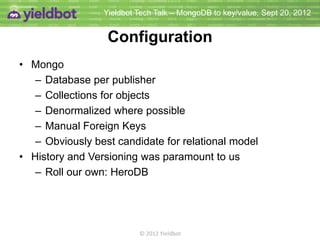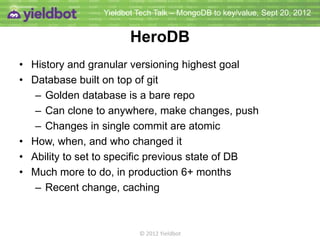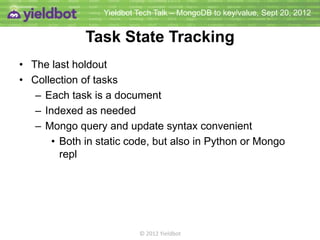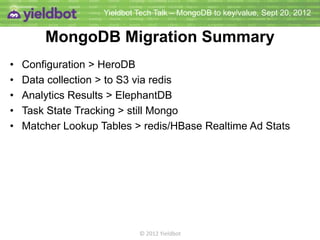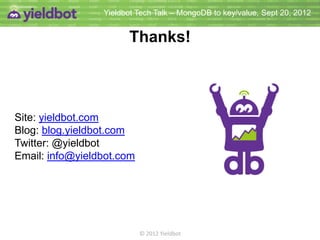Yieldbot Tech Talk, Sept 20, 2012
- 1. Yieldbot Tech Talk – MongoDB to k/v © 2012 Yieldbot © 2012 Yieldbot / CONFIDENTIAL
- 2. Yieldbot Tech Talk – MongoDB to key/value, Sept 20, 2012 What We Do • Yieldbot technology creates marketplaces where advertisers target realtime consumer intent flowing through premium publishers. • At a high level: Analytics + Ad Serving – Geo-distributed • Data collection • Realtime ad matching – Cascalog batch analytics – Rich Analytics Results visualizations © 2012 Yieldbot
- 3. Yieldbot Tech Talk – MongoDB to key/value, Sept 20, 2012 Why MongoDB (Dec 2009) • Needed manageable by dev team (1 person!) • Flexible • Easy to get started, run on laptop or deploy • Scale wasn’t initially biggest concern • Could focus on other stuff – Lucene – Analytics – Ad serving dynamics © 2012 Yieldbot
- 4. Yieldbot Tech Talk – MongoDB to key/value, Sept 20, 2012 How MongoDB Used Initially • Configuration – Publisher profiles, ad matching rules, etc. • Data collection – Pageviews, impressions, clicks • Analytics results • Task state tracking • Lookup tables for ad serving • Real-time ad stats © 2012 Yieldbot
- 5. Yieldbot Tech Talk – MongoDB to key/value, Sept 20, 2012 Couple Aspects of Note • Master/Slave – convenient for simple durability – convenient for geo distribution – not unique to Mongo, now similar redis topology • Indexing – Easy to set up, but eventually RAM scaling issue – initially great for efficient views of data in UI – moved analytics results as key/value in mongo • Durable sharded config (replica sets) expensive © 2012 Yieldbot
- 6. Yieldbot Tech Talk – MongoDB to key/value, Sept 20, 2012 Data Collection • Mongo: collections for pageviews, impressions, clicks – Wasn’t archived anywhere else – Not where you want to infinitely scale • Now flows through redis, to files, to S3 © 2012 Yieldbot
- 7. Yieldbot Tech Talk – MongoDB to key/value, Sept 20, 2012 Data Collection with redis Assist • redis lists populated as events come in • Daemons pull off lists and write to files • Periodically compress and archive files to S3 • S3 files used for input later – Hadoop (Cascalog) batch analytics – Advertising Stats Calculations © 2012 Yieldbot
- 8. Yieldbot Tech Talk – MongoDB to key/value, Sept 20, 2012 Matching Lookup Tables • Mongo: collections for different lookup types – Eg., geo, url – Built periodically, updated on config change – Lookup in each, correlate results • redis – Ability to pipeline operations in single server call – Set intersection across lookup dimensions and one response back – Same master/slave as Mongo for distribution © 2012 Yieldbot
- 9. Yieldbot Tech Talk – MongoDB to key/value, Sept 20, 2012 Configuration • Mongo – Database per publisher – Collections for objects – Denormalized where possible – Manual Foreign Keys – Obviously best candidate for relational model • History and Versioning was paramount to us – Roll our own: HeroDB © 2012 Yieldbot
- 10. Yieldbot Tech Talk – MongoDB to key/value, Sept 20, 2012 HeroDB • History and granular versioning highest goal • Database built on top of git – Golden database is a bare repo – Can clone to anywhere, make changes, push – Changes in single commit are atomic • How, when, and who changed it • Ability to set to specific previous state of DB • Much more to do, in production 6+ months – Recent change, caching © 2012 Yieldbot
- 11. Yieldbot Tech Talk – MongoDB to key/value, Sept 20, 2012 Analytics Results • ARCv1, Mongo: indexed collections – Very easy to code to – Initially with everything else in same server – Moved out to dedicated server – Memory became an issue • Indexes bigger than data itself – Overhead of importing Cascalog results • Pull json files from S3 to local disk • mongoimport files into DB © 2012 Yieldbot
- 12. Yieldbot Tech Talk – MongoDB to key/value, Sept 20, 2012 Analytics Results Cont’d • ARCv2, Mongo: paged data, key/value – Migrated app to key/value access pattern – Much better memory usage – Application sharded, publishers spread around – DB per day per publisher, most recent 7 held – Still overhead of importing Hadoop results • Pull json files from S3 to local disk • mongoimport files into DB © 2012 Yieldbot
- 13. Yieldbot Tech Talk – MongoDB to key/value, Sept 20, 2012 Analytics Results - ElephantDB • Cascalog support to directly write EDB format – Berkeley DB or LevelDB • Ring Topology – Shards distributed around ring, consistent hashing – Configurable replication factor – Request to any node, forwards as necessary – Incrementally increase ring size • Import from S3 efficient – Copy shard from S3 to local disk © 2012 Yieldbot
- 14. Yieldbot Tech Talk – MongoDB to key/value, Sept 20, 2012 Real-time Ad Stats • Mongo: DB per day, collection by entity type – Document per entity instance – stat_type.hour.minute nested values, atomic increment – Never a good story around aggregating at larger timeframes • Enter redis again © 2012 Yieldbot
- 15. Yieldbot Tech Talk – MongoDB to key/value, Sept 20, 2012 Real-time Ad Stats Cont’d • redis has robust access patterns – More pipelining • Initially realtime and aggregated kept in redis • Issue with redis scaling is DB has to fit in memory • Time-period aggregations now kept in HBase • Only most recent hours kept in redis © 2012 Yieldbot
- 16. Yieldbot Tech Talk – MongoDB to key/value, Sept 20, 2012 Task State Tracking • The last holdout • Collection of tasks – Each task is a document – Indexed as needed – Mongo query and update syntax convenient • Both in static code, but also in Python or Mongo repl © 2012 Yieldbot
- 17. Yieldbot Tech Talk – MongoDB to key/value, Sept 20, 2012 Honorable Mention • redis for the celery backend, used for task messaging infrastructure • but was never mongo anyway... © 2012 Yieldbot
- 18. Yieldbot Tech Talk – MongoDB to key/value, Sept 20, 2012 MongoDB Migration Summary • Configuration HeroDB • Data Collection to S3 via redis • Analytics Results ElephantDB • Task State Tracking still Mongo • Matcher Lookup Tables redis • Real-time Ad Stats redis/HBase © 2012 Yieldbot
- 19. Yieldbot Tech Talk – MongoDB to key/value, Sept 20, 2012 Thanks! Site: yieldbot.com Blog: blog.yieldbot.com Twitter: @yieldbot Email: info@yieldbot.com © 2012 Yieldbot








